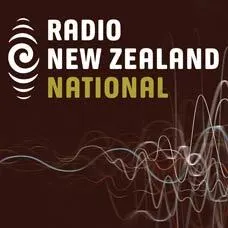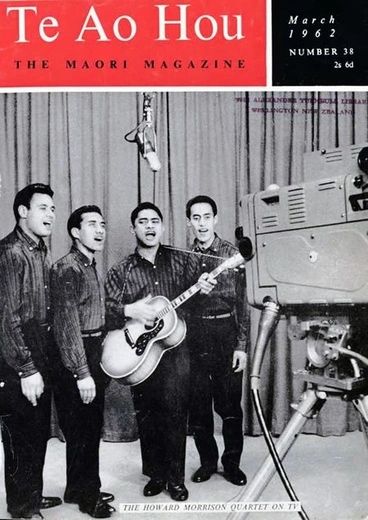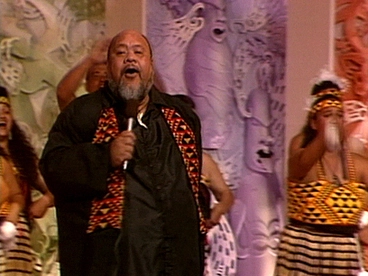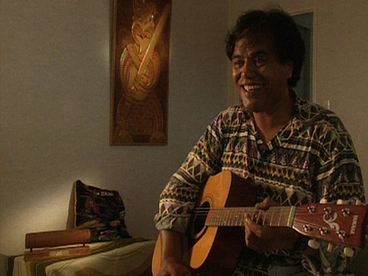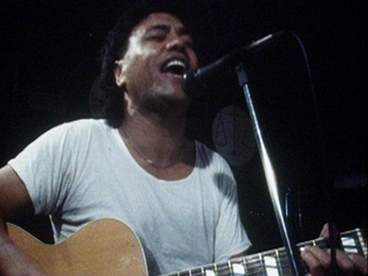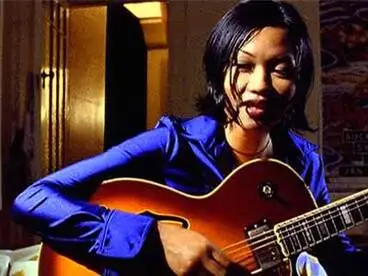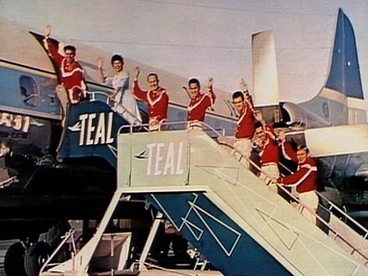Māori musicians, songwriters and performers
A DigitalNZ Story by National Library Services to Schools
This story provides links to resources about some of New Zealand's Māori musicians, songwriters and performers.
INTRODUCTION
Māori have always contributed to pop music, but from the 1960s there was little that celebrated Māori culture. With the Māori cultural renaissance of the 1980s, Māori musicians used music (sometimes reggae) to assert Māori identity. In 1984 ‘Poi e’ was a hit for the Pātea Māori Club. Māori songs serve purposes beyond entertainment. Karakia are used for social or religious occasions; traditional waiata describe past events or lament lost loved ones. In haka, warriors challenge rivals, using aggressive movements. Pātere are rhythmic recitations in which the performers might defend a reputation.
Source: Popular music, Te Ara - the Encyclopedia of New Zealand
'Ruaumoko' poster
Museum of New Zealand Te Papa Tongarewa
All Black George Nēpia's talents extended beyond the rugby field - he was also a musician and singer. His rendition of his cousin Walter Smith's song 'Beneath the Māori moon', recorded by British label Decca in 1936, was one of his major hits.
Source: Popular music - Recorded music, radio and dance music, 1900s to 1930s, Te Ara - the Encyclopedia of New Zealand
'Beneath the Māori moon', 1936
Manatū Taonga, the Ministry for Culture and Heritage
Ruru Karaitiana's 'Blue smoke' was the first record released by TANZA, and the first song written by a New Zealander to be recorded and processed locally and released on a local label. Karaitiana wrote the song in 1940 on the way to the battlefields of the Second World War and it became a favourite tune of the 28th (Māori) Battalion. The sheet music was published in 1947; the recording, by Pixie Williams, was released in 1949 and became a New Zealand classic.
Source: Popular music - Wartime music and early recording, 1930s and 1940s, Te Ara - the Encyclopedia of New Zealand
'Blue Smoke / Kohu-Auwahi' sheet music
Museum of New Zealand Te Papa Tongarewa
TE RANGI PAI/FANNY ROSE PORTER (NGĀTI POROU, TE WHĀNAU-Ā-APANUI)
Fanny Rose Porter (Poata), who was best known by her stage name, Te Rangi Pai, was born at Tokomaru Bay, according to family sources on 11 January 1868. She was the eldest of nine children of Herewaka Porourangi Pōtae (also known as Te Rangi-i-pāea) and her husband, Thomas William Porter. Possessed of a fine natural contralto voice, Fanny Porter began to perform in public and impressed visiting entertainers with her talent. She lacked formal training, though, and after hearing her sing in Gisborne in mid 1891, the touring Australian contralto Madame Patey urged her to study overseas. After marrying civil servant John Howie in Christchurch on 15 October 1891 she studied singing in Australia and is said to have toured there in 1898 before returning to New Zealand. By 1900 she was using as a stage name a shortened version of her mother's name, Te Rangi Pai, which means 'the beautiful sky'. In December that year Fanny departed for England to study with the baritone Charles Santley.
Source: Howie, Fanny Rose, Te Ara - the Encyclopedia of New Zealand
Fanny Rose Howie, known as Te Rangi Pai
Alexander Turnbull Library
"The Mikado"
Nelson Provincial Museum
Te Rangi Pai recital, 1906
Manatū Taonga, the Ministry for Culture and Heritage
ANA HATO (NGĀTI WHAKAUE, TŪHOURANGI)
By singing Māori songs in front of tribal audiences and tourists she developed sophistication and confidence as a soprano. Although unable to read music, she was noted for her accurate pitch. When Ana was 16 she was invited to join the concert party of Guide Rangi (Rangitiaria Dennan). Her reputation grew and she became much sought after as a soloist. The visit of the duke and duchess of York to Rotorua in 1927 provided an opportunity for tribes throughout the country to perform. Ana Hato featured at a concert in the old Tūnohopū meeting house, Ōhinemutu, and sang duets with her cousin, the tenor Deane Waretini. The event was recorded by the Parlophone Company from Australia, and this led to further recording engagements in Australia in 1929. Fourteen records were made in Australia and thousands were sold. Titles included ‘Pōkarekare’, ‘E pari rā’, ‘Hine e hine’ and ‘Waiata poi’. Duets in the 1930s produced New Zealand hit songs like ‘Honey’ and ‘Home little Māori home’.
Source: Hato, Ana Matawhāura, Te Ara - the Encyclopedia of New Zealand
‘Pōkarekare ana’ by Ana Hato and Deane Waretini
Manatū Taonga, the Ministry for Culture and Heritage
Oriwa Tahupotiki Haddon and Ana Hato
Alexander Turnbull Library
ĪNIA TE WIATA (NGĀTI MAHUTA)
Īnia Te Wīata’s rise from employment at the Horotiu freezing works near Ngāruawāhia to international fame is a remarkable story. Te Wīata (1915–71) made his debut at Covent Garden in 1951, singing alongside Bryan Drake in The pilgrim’s progress. Twenty years later he was to have sung the title role in Mussorgsky’s Boris Godunov on that same stage with a young Kiri Te Kanawa. On the first day of rehearsals, however, he became seriously ill and died a fortnight later. In the intervening years he had enjoyed a career of the utmost distinction. His various trips back to New Zealand included starring in the New Zealand Opera Company’s 1965 production of Gershwin’s Porgy and Bess, with an all-Māori cast.
Source: Classical musicians - Leading baritones and basses, Te Ara - the Encyclopedia of New Zealand
Signed portrait of Inia Te Wiata
Auckland Libraries
Inia Te Wiata as Johann Strauss Senior in a London production of The great waltz, 1970
Manatū Taonga, the Ministry for Culture and Heritage
PIXIE WILLIAMS (NGĀTI KAHUNGUNU)
Ruru Karaitiana's 'Blue smoke' was the first record released by Tanza, and the first song written by a New Zealander to be recorded and processed locally and released on a local label. Karaitiana wrote the song in 1940 on the way to the battlefields of the Second World War and it became a favourite tune of the 28th (Māori) Battalion. The sheet music was published in 1947; the recording, by Pixie Williams, was released in 1949 and became a New Zealand classic.
Source: Karaitiana, Rangi Ruru Wānanga, Te Ara - the Encyclopedia of New Zealand
Pixie Williams
Tauranga City Libraries
Pixie Williams
Radio New Zealand
KIRI TE KANAWA (NGĀTI MANIAPOTO)
Widely regarded as one of the greatest living New Zealanders, Kiri Te Kanawa, born in Gisborne in 1944, has lived most of her life in England with periodic visits to New Zealand. After winning all the major Australasian vocal prizes, Te Kanawa moved to England in 1965 to study at the London Opera Centre and, later, with former Vienna Opera star Vera Rozsa. Her breakthrough role was Countess Almaviva in Mozart's Marriage of Figaro at the Royal Opera House in 1971, and she became an overnight sensation. As well as taking leading roles in operas by Mozart, Verdi, Richard and Johann Strauss, Puccini, Bizet and Tchaikovsky, she made concert appearances with the world's greatest orchestras and recorded extensively. In 2004 she launched the Kiri Te Kanawa Foundation to provide financial assistance to young New Zealand musicians. Made a Dame Commander of the British Empire in 1982, she joined the prestigious Order of New Zealand in 1995.
Source: Creative and intellectual expatriates - Attitudes to expatriation, Te Ara - the Encyclopedia of New Zealand
Kiri Te Kanawa
Manatū Taonga, the Ministry for Culture and Heritage
DAME KIRI TE KANAWA
Our Wāhine
Sydney: Kiri Te Kanawa "La Traviata"
Museum of New Zealand Te Papa Tongarewa
HIRINI MELBOURNE (NGĀI TŪHOE, NGĀTI KAHUNGUNU)
Hirini Melbourne of Ngāi Tūhoe was an influential composer whose works and creativity flourished from 1980 till his death in 2003. Melbourne first came to be known through the many songs he composed for schools, which are still sung in the 2000s. ‘Pūrea nei’ (Cleansing), ‘Whiti te marama’ (The moon shines), ‘Tihore mai’ (The sky is clear) and many more are popular favourites and sung throughout New Zealand.Melbourne is also lauded for his leadership – with Richard Nunns – in the revival of traditional Māori musical instruments known as taonga puoro (sound treasures). Their 1994 CD Te ku te whe was a landmark recording, restoring the sounds of these instruments and introducing a new voice in New Zealand music composition. In the 2010s taonga puoro can be heard in film and television, at sports games, on marae and elsewhere.
Source: Māori composers – ngā kaitito waiata - Later composers, Te Ara - the Encyclopedia of New Zealand
Hirini Melbourne
SOUNZ
Today in music history: Hirini Melbourne born
Radio New Zealand
Hirini Melbourne and Richard Nunns
Alexander Turnbull Library
PRINCE TUI TEKA (NGĀI TŪHOE)
In the early 1950s Prince Tui Teka joined the circus, which took him to Australia. He started out cleaning up after the animals but soon moved on to performing. Teka left the circus to join a Māori showband which toured throughout Australia. In 1966 he joined the Māori Volcanics and travelled around the world with the group. After the Māori Volcanics broke up, Teka worked in the club scene of Australia and south-east Asia, before returning to New Zealand for good in 1981. His song 'E ipo' (1982) was the first Māori-language song to reach number one in the New Zealand music charts, where it spent two weeks in 1982. Here, Teka is shown performing with the Māori Volcanics in Sydney in the 1970s.
Source: Popular music - Māori and Pacific music, 1980s and 1990s, Te Ara - the Encyclopedia of New Zealand
E Ipo
NZ On Screen
Prince Tui Teka
Radio New Zealand
Prince Tui Teka
Manatū Taonga, the Ministry for Culture and Heritage
HOWARD MORRISON (TE ARAWA)
Another entertainment phenomenon that began in 1958 reached a much wider cross-section of New Zealanders. The Howard Morrison Quartet was a music and comedy act from Rotorua, capable of polished vocal versions of pop standards and originals, song parodies and humorous patter.Morrison, the leader, had grown up listening to sweet vocal harmony groups such as the Mills Brothers and the Ink Spots. His love of Neapolitan music was nurtured by veterans of the Māori Battalion’s campaign in Italy – he described himself as ‘Mario Māori Lanza’.
Source: Popular music - Rock ’n’ roll and the Howard Morrison Quartet, Te Ara - the Encyclopedia of New Zealand
Howard Morrison
NZ On Screen
Feature Interview: Sir Howard Morrison
Radio New Zealand
Howard Morrison quartet
Manatū Taonga, the Ministry for Culture and Heritage
DALVANIUS PRIME (TAINUI, NGĀ PUHI, NGĀTI RUANUI, TŪWHARETOA, NGĀ RAURU, PAKAKOHI, KAI TAHU)
Dalvanius Prime worked the Australian club circuit in the 1970s as Dalvanius and the Fascinations, and formed a production company called Maui Records in New Zealand in 1983. From then he concentrated on Māori music. His best-known song, 'Poi e', was the result of a collaboration with East Cape writer Ngoi Pēwhairangi and was intended to make Māori children feel proud of their ethnicity. It was sung by the Pātea Maori Club to an infectious break-dance rhythm, successfully fusing traditional Māori culture with up-to-the-minute urban sounds. The song was in the New Zealand music charts for 22 weeks in 1984, including four weeks at number one. It re-entered the charts in 2010, popularised by the movie Boy.
Source: Popular music - Māori and Pacific music, 1980s and 1990s, Te Ara - the Encyclopedia of New Zealand
Dalvanius
NZ On Screen
The life and legacy of Dalvanius Prime
Radio New Zealand
Ngoi Ngoi - performed by Pātea Māori Club
NZ On Screen
JOHN ROWLES
John Rowles
NZ On Screen
John Rowles: Musical Chairs
Radio New Zealand
John Rowles
Manatū Taonga, the Ministry for Culture and Heritage
RICKY MAY
Ricky May Special
NZ On Screen
BUNNY WALTERS
Sweet Soul Music - First Episode
NZ On Screen
Ten Guitars
NZ On Screen
Koha - Māori Musicians
NZ On Screen
WHIRIMAKO BLACK (NGĀTI TUHOE, NGĀTI TUWHARETOA, NGĀTI RANGINUI, TE WHAKATOHEA, TE WHANAU-A-APANUI)
Whirimako Black
SOUNZ
Big Year interview - Whirimako Black
Radio New Zealand
Making Music - Whirimako Black
NZ On Screen
NGATAPA BLACK (NGĀI TŪHOE, TUWHARETOA, TE WHĀNAU-Ā-APANUI)
The Black Legacy
NZ On Screen
Ngatapa Black
SOUNZ
TINA CROSS (TE AUPOURI, NGĀTI POROU)
Nothing But Dreams - performed by Tina Cross
NZ On Screen
Entertainer Tina Cross
Radio New Zealand
Tina Cross
SOUNZ
MOANA MANIAPOTO (NGĀTI TUWHARETOA, TUHOURANGI, NGĀTI PIKIAO)
Moana Maniapoto is inducted into the NZ Music Hall of Fame
Radio New Zealand
Masterpieces: Moana Maniapoto
Radio New Zealand
Moana Maniapoto
Radio New Zealand
TAMA WAIPARA (RUAPANI, RONGOWHAKAATA, NGĀTI POROU)
BIC RUNGA (NGĀTI KAHUNGUNU)
Drive
NZ On Screen
Bic Runga
Manatū Taonga, the Ministry for Culture and Heritage
Photographs of Bic Runga
Alexander Turnbull Library
TIKI TAANE (NGĀTI MANIAPOTO)
Tiki Taane
NZ On Screen
Feature Guest - Tiki Taane
Radio New Zealand
Sonic Museum
Auckland War Memorial Museum Tāmaki Paenga Hira
MAISEY RIKA (NGATI AWA, TE ARAWA, TŪHOE, TE WHĀNAU-Ā-ĀPANUI)
Maisey Rika
SOUNZ
The Mixtape: Maisey Rika
Radio New Zealand
CHE FU
High Beams feat. Che Fu live at RNZ | 'Sky High'
Radio New Zealand
Essential New Zealand Albums: Che Fu - Navigator
Radio New Zealand
Misty Frequencies
NZ On Screen
EMMA PAKI
Greenstone
NZ On Screen
Emma Paki at Te Papa Stand Alone
Museum of New Zealand Te Papa Tongarewa
ANIKA MOA
LATE at the Museum: 'Innovate Food'
Auckland War Memorial Museum Tāmaki Paenga Hira
Anika Moa
Radio New Zealand
HINEWEHI MOHI (NGĀTI KAHUNGUNU, NGĀI TŪHOE)
Hinewehi Mohi
Radio New Zealand
Making Music - Hinewehi Mohi
NZ On Screen
ROB RUHA (NGĀTI POROU, TE WHĀNAU-Ā-APANUI)
Feature - Rob Ruha: That's Us
NZ Musician
Rob Ruha: Māori music, mentorship and 'Moana'
Radio New Zealand
Rob Ruha - Te Wiki o te reo Māori
Radio New Zealand
RIA HALL (NGĀI TE RANGI, NGĀTI RANGINUI)
Headquarters: Ria Hall
Radio New Zealand
Feature - Ria Hall: Pride Over Prejudice
NZ Musician
ARIANA TIKAO (KAI TAHU)
Ariana Tikao
SOUNZ
Arts Laureate Ariana Tikao: the power of pūoro
Radio New Zealand
Ariana Tikao performs in the Central Library
Christchurch City Libraries
SETH HAAPU (NGĀTI POROU)
STAN WALKER (TŪHOE, NGĀTI TŪWHARETOA)
TEEKS/TE KAREHANA GARDINER-TOI (NGĀ PUHI, NGĀI TE RANGI, NGĀTI RANGINUI)
TEEKS
SOUNZ
Teeks 'Wash Over Me' live
Radio New Zealand
Teeks wins Te Māngai Pāho Best Māori Artist
Radio New Zealand
PERE WIHONGI (TE RARAWA, NGĀ PUHI, NGĀTI KURI, NGĀTI WAI) & MAIMOA
Feature - NewTracks New Artist: Pere
NZ Musician
Pere Wihongi
SOUNZ
Feature - Maimoa: Collective Influence
NZ Musician
MOHI ALLEN (NGĀPUHI, TE RARAWA, NGĀI TE RANGI, NGĀTI KI TE WAIROA)
Feature - NewTracks New Artist: Mohi
NZ Musician
MĀORI SHOW BANDS
Te Ao Hou
Manatū Taonga, the Ministry for Culture and Heritage
The Quin Tikis
Manatū Taonga, the Ministry for Culture and Heritage
The Maori Show Bands Part 1: Music Was A Hunger
Radio New Zealand
AudioCulture: Ike Metekingi & the Maori Show Bands
Radio New Zealand
Howard Morrison Quartet, at the James Smith's Fair, Wellington
Alexander Turnbull Library
This story was curated and compiled by Te Puna Mātauranga o Aotearoa | National Library of New Zealand, Services to Schools staff, November 2020 and updated in December 2021.




